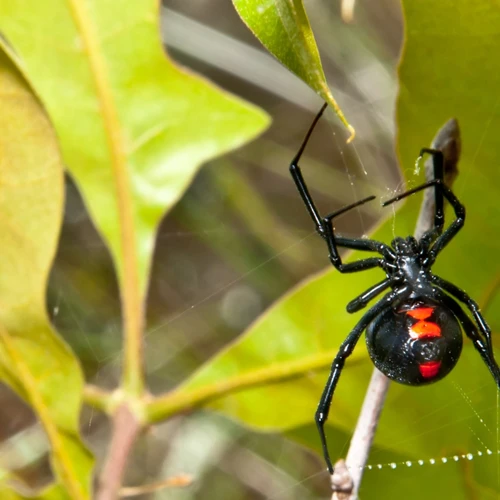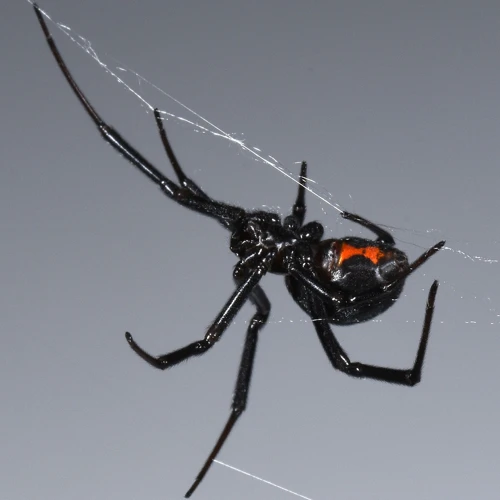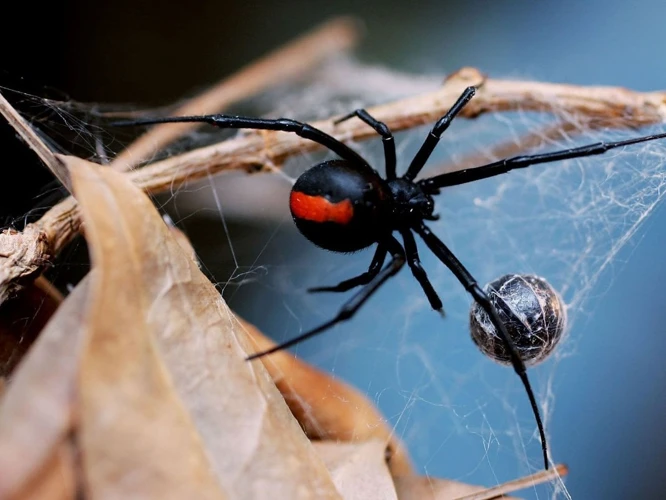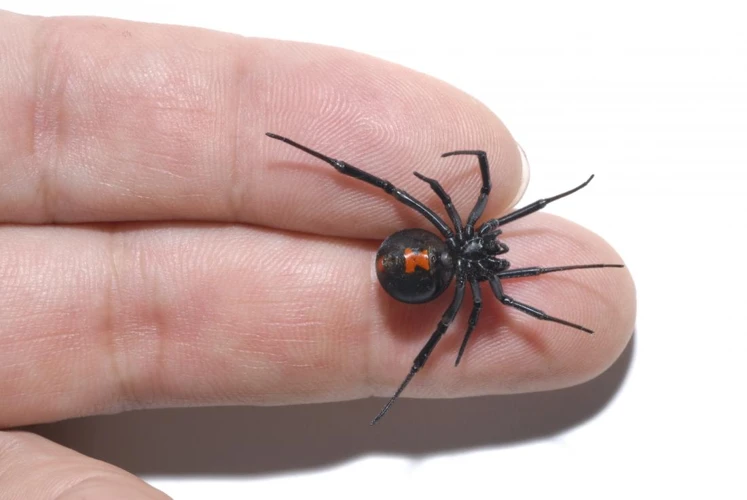The black widow spider is notorious for its venomous bite, which can cause severe symptoms such as muscle cramps, nausea, and even death in some cases. However, did you know that the potency of black widow venom varies depending on the region where the spider is found? This intriguing phenomenon has captured the attention of researchers, who have studied the factors that contribute to regional differences in venom potency. In this article, we will explore the characteristics of black widow spiders, the components and potency of their venom, and the fascinating world of regional variation in black widow venom potency. We will also examine the symptoms of a black widow bite, potential treatments, and methods of prevention. Get ready to delve into the mysterious world of these venomous spiders!
Black Widow Spiders

While the black widow spider is a familiar name to most individuals, there are still many perplexing characteristics surrounding these arachnids. From their habitat to venom potency, black widow spiders remain shrouded in mystery. However, by examining their characteristics, distribution, and types, we can begin to unravel the mysteries of these fascinating creatures. A better understanding of black widow spiders can aid in identifying potential risks and avoiding their bites. To learn more about black widow spiders, continue reading below. And for more information on black widow venom and its effects, be sure to check out our article on black widow venom risk.
1.1 Characteristics of Black Widow Spiders
Black widow spiders are some of the most recognizable and feared spiders in the world. They are known for their distinctive appearance and potent venom. In this section, we will discuss the characteristics of black widow spiders in more detail.
| Characteristics | Description |
|---|---|
| Appearance | Black widow spiders are typically black or dark brown with a shiny, globular abdomen. Females feature the iconic red hourglass-shaped marking on their underside, while males often have red or white spots on their back. |
| Size | Adult black widow spiders range from around 1.5 to 1.75 inches in length, including their leg span. |
| Behavior | Black widow spiders are typically solitary and nocturnal, preferring to hide in secluded areas during the day. They are known for their web-weaving abilities and create irregularly shaped webs, with individual strands much stronger than steel strands of the same diameter. |
| Habitat | Black widow spiders can be found in a variety of habitats, including woodlands, fields, and urban areas. They prefer dark, dry places, such as sheds, garages, and crawl spaces. |
Black widow spiders are found throughout much of the world, and there are several different species. Understanding their characteristics and behaviors can help people identify and avoid these venomous spiders. If you want to know more about the history of black widow venom, you can read our article dedicated to this topic.
1.2 Distribution of Black Widow Spiders
Black widow spiders are primarily found in warm, dry regions of the world, including the Americas, southern Europe, Africa, and Asia. However, they are most commonly associated with North America. In the United States, they are found in every state except Alaska. They are commonly found in outdoor areas such as woodpiles, rubble piles, and under stones and other debris. They may also be found inside buildings, particularly in basements, closets, and garages.
Black widow spiders are most abundant in areas with a temperate climate. They prefer areas with low humidity and a temperature range of 70°F to 90°F. In the southern United States, they are found throughout the year, while in the northern states, they are usually only found during the summer months.
It is important to note that black widow spiders do not typically seek out humans and will only bite when they feel threatened. However, it is still important to take precautions when in their habitat to avoid being bitten. For more information on the symptoms, treatment, and prevention of black widow spider bites, please see section 4 of this article.
1.3 Types of Black Widow Spiders
Black widow spiders are typically known for their venomous bites, which can cause a wide range of symptoms in humans. There are three main types of black widow spiders:
- Latrodectus mactans: also known as the Southern black widow, this species is found in the southeastern United States and Mexico.
- Latrodectus hesperus: also known as the Western black widow, this species is found in western North America from Canada to Mexico.
- Latrodectus variolus: also known as the Northern black widow, this species is found in the northeastern United States, southeastern Canada, and adjacent areas of Mexico.
Each species has distinctive markings on their bodies, with the female exhibiting a shiny, black body and the male displaying a smaller size and lighter coloring. While all three types of black widow spiders are venomous, their venom potency can vary depending on the region in which they live and other factors such as their diet and environmental conditions.
To learn more about the components and potency of black widow venom, check out our article on black widow spider venom chemistry and effects. For information on the symptoms and treatment of black widow bites, see our article on black widow spider bite symptoms, treatment, and prevention.
Black Widow Venom Potency

The Black Widow spider is notorious for being one of the most venomous spiders in the world. The potency of their venom is surprisingly powerful, and even more perplexing is the fact that its impact can vary depending on various factors. Understanding this venom’s potency is key to understanding the nature of Black Widows and their potential impact on humans. Let’s take a deeper look at the Black Widow Venom Potency.
2.1 Components of Black Widow Venom
Black widow venom is a potent cocktail of various proteins, enzymes, and other molecules. Sixteen different proteins and enzymes have been identified in black widow venom, where alpha-latrotoxin is the most critical component responsible for producing severe effects during a bite. Other significant components include acetylcholine, calcium ion channel blockers, and latroinsectotoxins.
Acetylcholine present in the black widow venom increases the release of acetylcholine at the neuromuscular junctions, causing muscles to contract uncontrollably, leading to neurological effects. The calcium ion channel blockers prevent the release of neurotransmitters that lead to muscle relaxation. In contrast, the latroinsectotoxins in the venom also contribute towards insects’ paralysis and death, making them an essential part of the spider’s defense mechanism.
The black widow venom contains several enzymes like hyaluronidase, phospholipase, and protease. Hyaluronidase facilitates the diffusion of venom by breaking down the interstitial tissue, while the proteases stimulate pain receptors by breaking down tissues.
Finally, nucleotides, lipids, and free amino acids also form an essential component of the black widow venom. The presence of these molecules alongside other components helps create the physiological response observed in humans.
It is due to the numerous complex components that black widow venom is a potent neurotoxin capable of causing harm to humans. Understanding the venom’s complexity can help develop more effective antidotes for treating its bites in the future.
2.2 Potency of Black Widow Venom
Black Widow venom is a highly potent toxin that can cause severe health effects and even death in some cases, especially in children and the elderly. The potency of the venom can vary among different species and regions. The toxin is a complex mixture of several molecules, including neurotoxins that affect the nervous system, as well as enzymes and peptides that can cause tissue damage.
The potency of the Black Widow venom varies depending on the species. The venom of the Southern black widow (Latrodectus mactans), for example, is considered to be more potent than that of the Northern black widow (Latrodectus variolus). This difference in potency can be attributed to the differences in the composition of their venom as well as their geographic distribution.
Another factor affecting the potency of Black Widow venom is the age and sex of the spider. Female Black Widows tend to have more potent venom than males, as their venom is used for defensive purposes and capturing prey, while the males do not use their venom for hunting. The venom potency of the Black Widow also increases with age, which may be attributed to the accumulation of toxins over time.
Moreover, the potency of Black Widow venom can vary even within a species depending on its geographic location. For example, a study found that the venom of Latrodectus tredecimguttatus, a species of Black Widow found in different parts of the Mediterranean, had significant differences in potency. In some regions, the venom was found to be much more potent than in other areas.
It’s essential to understand the potency of Black Widow venom to take necessary precautions to avoid being bitten by these spiders. Knowing the potential severity of the health effects can help individuals to seek medical treatment immediately if they suspect a Black Widow bite. Awareness and caution are paramount when residing in areas where Black Widows may be found.
If you want to learn more about the effects of Black Widow venom on the respiratory system, follow the link to read our article on Black Widow venom effects on the respiratory system.
2.3 Factors Affecting Venom Potency
Multiple factors can affect the potency of black widow venom. Here are some of the most significant ones:
- Age of the Spider: The age of the spider plays a role in venom potency. Studies have found that younger black widow spiders typically produce venom that is more potent than that of older black widow spiders.
- Time of Year: The time of year can also affect the venom potency of black widow spiders. Researchers have found that venom produced during the spring and summer is more toxic than venom produced in the fall and winter.
- Location: The location of black widow spiders can also play a part in the potency of their venom. For example, black widows that live in areas with more prey tend to have stronger venom because they need to immobilize larger and more dangerous prey.
- Diet: The diet of black widow spiders can also affect the potency of their venom. Spiders that feed on a diet rich in protein produce venom that is more potent than those that feed on a diet with less protein.
Understanding these factors can help researchers develop more effective antivenoms and provide doctors with a better understanding of what to expect when treating patients who have been bitten by black widow spiders. By taking into account factors such as location and time of year, doctors can more accurately diagnose and treat patients who have been bitten, potentially improving their chances of a full recovery. For more information about black widow venom, see also our article on Evolution of Black Widow Venom.
Regional Variation in Black Widow Venom Potency

As terrifying as a black widow spider bite can be, there is even more perplexity when it comes to the venom potency of this arachnid. The venom of black widow spiders has a varying level of potency, depending on their geographic location. This leads to regional differences in the severity of bites. While some studies have been conducted to understand this variation, it remains a mystery to many. Let’s dive deeper into the fascinating world of regional variation in black widow venom potency and explore its possible explanations.
3.1 Studies on Venom Potency Variation
According to various studies, the potency of black widow venom varies depending on the location of the spider. Researchers across the globe have noted differences in the composition and effects of the venom from black widow spiders in different geographical regions.
One study conducted in the United States found that venom from black widow spiders in Florida was more potent than the venom produced by spiders in California. Another study conducted in Latin America found variations in venom potency within the same country.
| Location | Spider Species | Venom Potency |
|---|---|---|
| Florida, USA | Latrodectus mactans | 15.3 ± 2.6 μg/kg |
| California, USA | Latrodectus hesperus | 2.2 ± 0.4 μg/kg |
| Córdoba, Argentina | Latrodectus curacaviensis | 5.1 μg/kg |
| Salta, Argentina | Latrodectus corallinus | 9.9 ± 2.7 μg/kg |
While the exact reasons for these variations are still being researched, it is believed that factors such as environmental conditions, prey availability, and genetic differences may contribute to the differences in venom potency.
Understanding the regional variations in black widow venom potency is crucial for developing effective antivenom treatments for spider bites. It also highlights the importance of proper identification of the specific spider species causing the bite, as different species can produce varying levels of venom.
To learn more about the effects of black widow venom and its potential medical uses, check out our article on Black Widow Venom CVs. Additionally, for more information on the habitat of black widow spiders and susceptibility to their bites, visit our article on Habitat Black Widow Bite Susceptibility.
3.2 Factors Affecting Regional Variation
Regional variations in black widow venom potency can be attributed to several factors, including climate, altitude, and prey availability. These factors can affect the abundance of certain toxins in the venom of black widow spiders found in different regions.
One study compared the venom potency of black widow spiders from coastal and inland regions of Australia. The coastal spiders were found to have higher levels of latrotoxins than the inland spiders. This may be due to the presence of more suitable prey for the coastal spiders, or differences in temperature and humidity between the two regions.
Another study looked at black widow spiders found in different regions of the United States. The researchers found that spiders from the southern regions, such as Florida, had venom that was much more toxic than spiders from northern regions, such as Canada. This was attributed to the warmer climate in the south, which allowed the spiders to produce more potent venom.
An interesting factor that can influence regional variation is competition with other venomous animals. In areas where black widows share habitats with other venomous animals, such as snakes or scorpions, they may produce more potent venom to compete for resources.
Understanding the factors that affect regional variation in black widow venom potency is crucial for developing effective antivenom treatments and managing the risks of black widow bites in different regions. Further research can help us better understand the complex interactions between black widows and their environment.
For more information about black widow venom and its effects on humans, refer to our article on black widow venom and CVS system.
3.3 Examples of Regional Variation
When it comes to regional variation in black widow venom potency, there are several examples to consider. Research has shown that black widow venom can vary in potency, even within the same species, depending on the location where the spider is found.
Example 1: A study published in the Journal of Arachnology found that black widow venom from specimens collected in California was four times more potent than venom from specimens collected in Florida. The researchers suggested that this difference in potency could be due to variations in diet and environmental factors between the two regions.
Example 2: Another study published in Toxicon looked at the venom of black widows from different parts of Brazil. The researchers found that venom from spiders in the Southeastern region of the country was more potent than venom from spiders in the Northern region. They hypothesized that this could be due to differences in prey availability and habitat type.
Example 3: In a study published in PLOS ONE, researchers compared the venom of black widows from two different regions of South Africa: the Western Cape and Limpopo. They found that venom from spiders in the Western Cape was more potent than venom from spiders in Limpopo. The researchers suggested that this could be due to differences in temperature and humidity between the two regions.
To summarize, these examples demonstrate the existence of regional variation in black widow venom potency. It’s important to keep in mind that factors such as diet, habitat, and climate can all influence the toxicity of the venom produced by these spiders.
Symptoms, Treatment, and Prevention
As with any venomous creature, it’s important to know the potential symptoms, treatments, and ways to prevent bites or stings. In the case of black widow spiders, being aware of the signs of a bite, knowing how to treat it, and taking steps to avoid encounters can help reduce the risk of a serious reaction. Let’s explore the symptoms, treatment options, and preventative measures when dealing with black widow spider bites.
4.1 Symptoms of Black Widow Bite
When bitten by a black widow spider, the victim may experience a variety of symptoms. These symptoms can range from mild to severe, and may include:
| Symptoms | Description |
|---|---|
| Pain | The bite often causes intense, localized pain that may spread to other areas of the body. |
| Cramping | The victim may experience abdominal cramping, muscle cramps, or rigidity. |
| Sweating | The bite may cause excessive sweating, particularly around the bite area. |
| Nausea and vomiting | Some victims may experience nausea, vomiting, and/or diarrhea. |
| Fever | The victim may develop a fever or feel feverish. |
| General malaise | The victim may feel generally unwell or fatigued. |
It’s important to note that symptoms may vary depending on the age and health of the victim, as well as the amount of venom injected by the spider. In some cases, victims may experience no symptoms at all. If you suspect you or someone you know has been bitten by a black widow spider, seek medical attention immediately.
4.2 Treatment of Black Widow Bite
When it comes to treating a black widow bite, time is of the essence. If a person suspects they have been bitten, they should seek medical attention immediately. An anti-venom is available for black widow bites, and it is the most effective treatment for neutralizing the venom. The anti-venom can alleviate the symptoms of a bite within an hour or less and can be given intravenously.
Table: Treatment Options for Black Widow Bite
| Treatment Option | Details |
|---|---|
| Antivenom | Prescription medication that neutralizes the venom. Most effective treatment for black widow bites. Administered intravenously. |
| Pain Management | Over-the-counter pain relievers such as acetaminophen and ibuprofen can help alleviate pain and discomfort. |
| Muscle Relaxants | Prescription medication that can help relieve muscle cramps and spasms. |
| Rest and Hydration | Rest and drink plenty of fluids to help the body recover. |
In addition to receiving the anti-venom, a person may also be given pain medication and muscle relaxants to alleviate symptoms. It is important to rest and stay hydrated to aid in the body’s recovery process. Most people who receive treatment for a black widow bite recover fully without any lasting effects. However, it is essential to seek medical attention as soon as possible to ensure the best possible outcome.
4.3 Prevention of Black Widow Bite
Preventing a black widow bite is the best way to avoid the symptoms and potential dangers associated with their venom. Here are some measures that can be taken to prevent bites from black widow spiders:
| Measure | Description |
|---|---|
| Wear protective clothing | When working outside or in areas where black widow spiders may be present, wear long sleeves, pants, and gloves to minimize exposed skin. |
| Inspect outdoor areas | Regularly inspect areas around your home or workplace, such as woodpiles, garages, and storage sheds. Black widows frequently hide in dark, undisturbed areas. |
| Seal cracks and crevices | Seal cracks and crevices around foundations, doors, and windows. This will prevent black widows from entering the living areas of your home. |
| Reduce clutter | Remove clutter and excess debris, such as boxes, unused items, and old furniture that can provide hiding spots for black widow spiders. |
| Use natural predators | Consider introducing natural predators into your environment. Birds, lizards and other animals are known to prey on black widows. |
By taking these measures, the likelihood of encountering a black widow spider can be significantly reduced. If you do spot a black widow spider, it is best to call a pest control professional to safely remove it. Remember, prevention is key when it comes to avoiding bites from these venomous spiders.
Conclusion
In conclusion, the potency of black widow venom can vary greatly depending on several factors such as age, sex, and location. While some regions may have higher potency venom than others, it is important to recognize the symptoms of a black widow bite regardless of where you are.
Symptoms of a black widow bite can include intense pain, muscle cramping, nausea, and vomiting. In severe cases, the bite can cause paralysis or even death.
Treatment for a black widow bite involves seeking immediate medical attention. Antivenom is available, and pain relief medication may also be administered.
Prevention of black widow bites can be achieved by taking precautions such as shaking out shoes and clothing before wearing them, using insect repellent, and avoiding areas where black widow spiders are known to reside.
Overall, while the potency of black widow venom may vary across regions, it is important to take necessary precautions and seek medical attention if bitten.
Frequently Asked Questions
What is the scientific name for black widow spiders?
The scientific name for black widow spiders is Latrodectus.
How many species of black widow spiders are there?
There are 32 recognized species of black widow spiders.
How venomous are black widow spiders?
Black widow spiders are highly venomous and their venom contains neurotoxins that affect the nervous system of their prey and can cause serious symptoms in humans.
What are the components of black widow venom?
Black widow venom is composed of a complex mixture of proteins, enzymes, and other molecules such as α-latrotoxin, which is a potent neurotoxin that affects neurotransmitter release in the brain.
What are the symptoms of a black widow bite?
The symptoms of a black widow bite include pain and swelling at the bite site, muscle cramps, spasms, and stiffness, fever, chills, sweating, and high blood pressure.
What is the treatment for a black widow bite?
The treatment for a black widow spider bite includes the application of ice to the bite site, pain relievers, muscle relaxants, and antivenom in severe cases.
How can you prevent a black widow bite?
You can prevent a black widow spider bite by wearing protective clothing, shaking out clothing and shoes before use, and keeping your living space clean and clutter-free.
What is the distribution of black widow spiders?
Black widow spiders are found throughout the world, but are most commonly found in warmer climates such as the southern United States, Central and South America, Australia, and southern Africa.
What are the factors that affect black widow venom potency?
The factors that affect black widow venom potency include the species of spider, the age and size of the spider, and environmental factors such as temperature and availability of prey.
How do black widow spiders defend themselves?
Black widow spiders defend themselves by using their venom as a means of immobilizing their prey and as a defense mechanism against potential predators.






